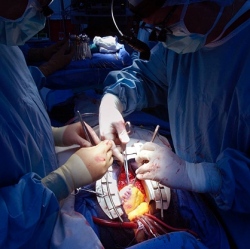
Researchers found that nanoparticles coated with targeting proteins can stimulate stem cells to regenerate bone. They were also able to deliver the cells to the injured area, remotely controlling the nanoparticles to generate forces and maintain the regeneration process through staged releases of a protein growth stimulant.
The current method for repairing bone that can’t heal itself is through a graft taken from the patient. Unfortunately, this can be a painful, invasive procedure, and when the area that needs repair is too large or the patient has a skeletal disorder such as there can sometimes be a lack of healthy bone for grafting.
For this reason, spurring the growth of new bone through injected stem cells is an area of great interest to medical researchers. Much progress has been made, but a major hurdle remains, finding an appropriate means to stimulate the differentiation of the stem cells so they become the quality of bone tissue needed in a quantity large enough to treat patients effectively.
James Henstock, PhD led the Biotechnology and Biological Sciences Research Council (BBSRC)-funded study, alongside Professor Alicia El Haj, and colleagues at Keele University’s Research Institute for Science and Technology in Medicine, as well as Kevin Shakesheff, PhD, from the University of Nottingham’s School of Pharmacy.
James Henstock said: “Injectable therapies for regenerative medicine show great potential as a minimally invasive route for introducing therapeutic stem cells, drug delivery vehicles and biomaterials efficiently to wound sites. In our investigation we coated magnetic nanoparticles with specific targeting proteins then controlled them remotely with an external magnetic field to simulate exercise. We wanted to learn how this might affect the injected stem cells and their ability to restore functional bone.”
